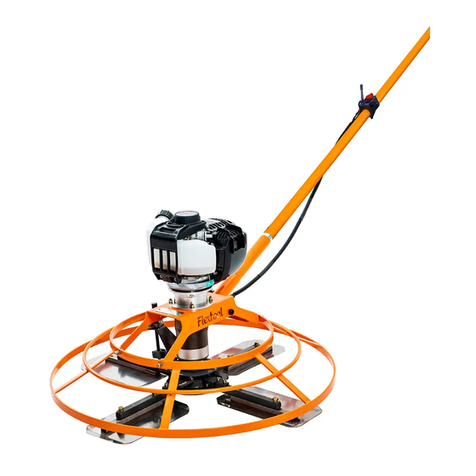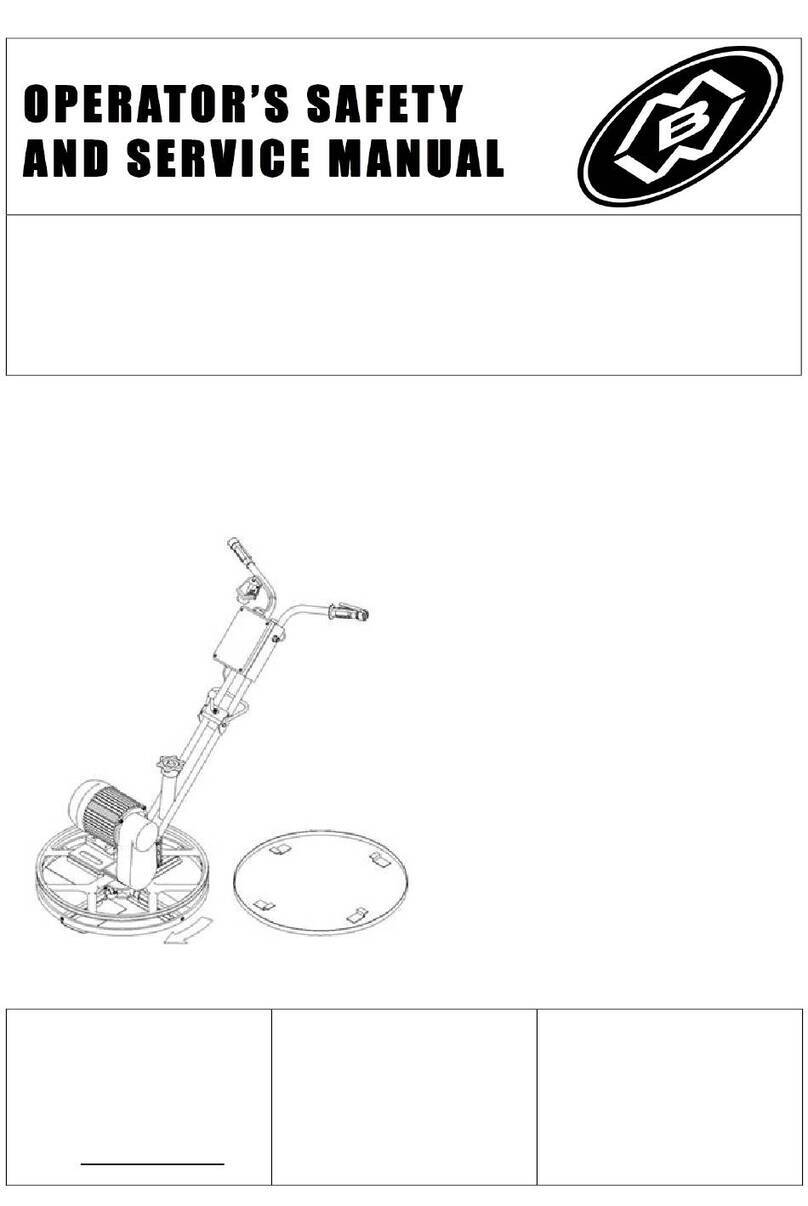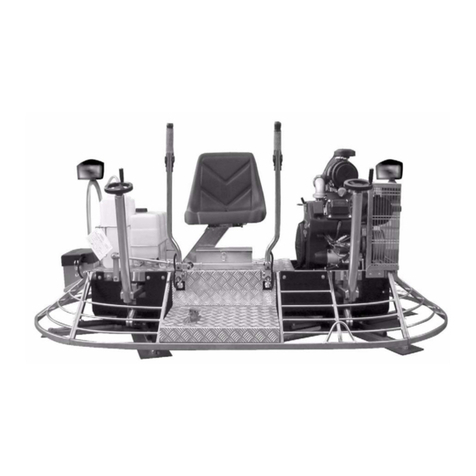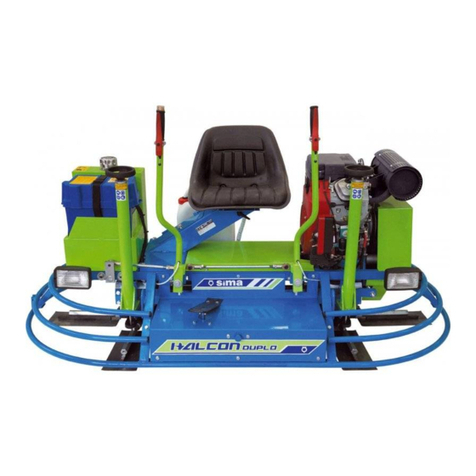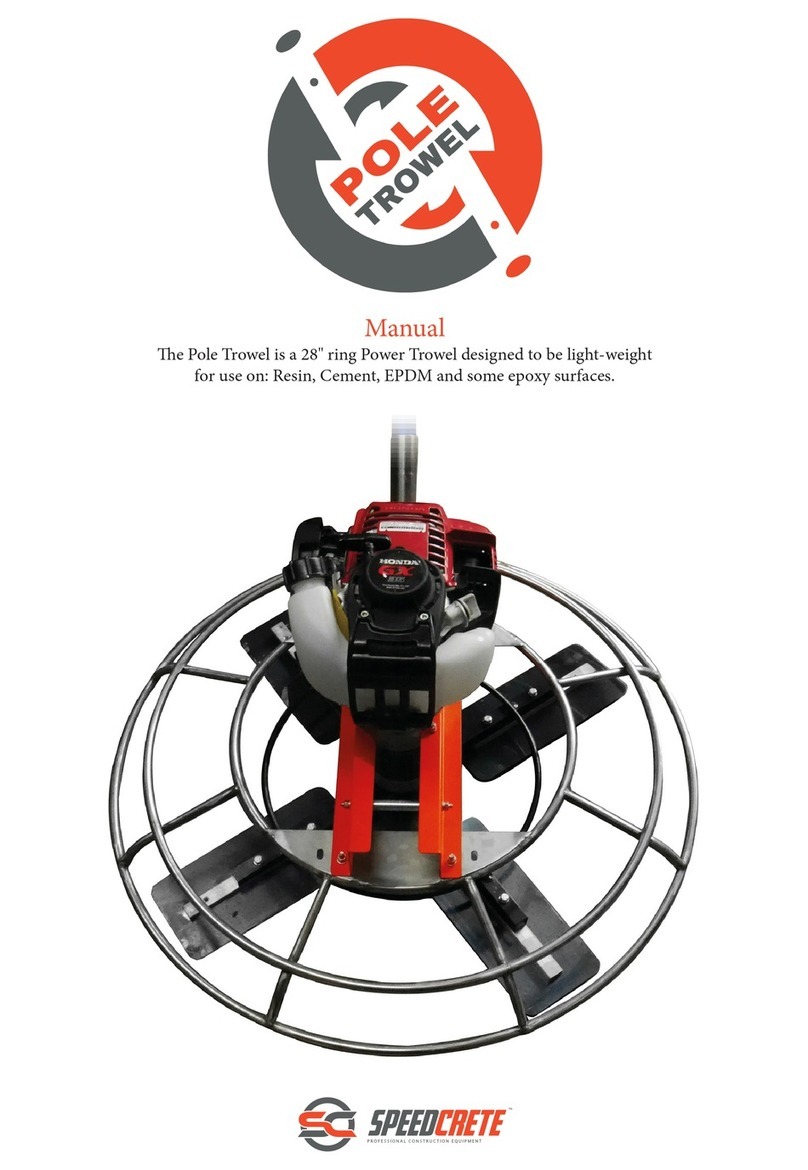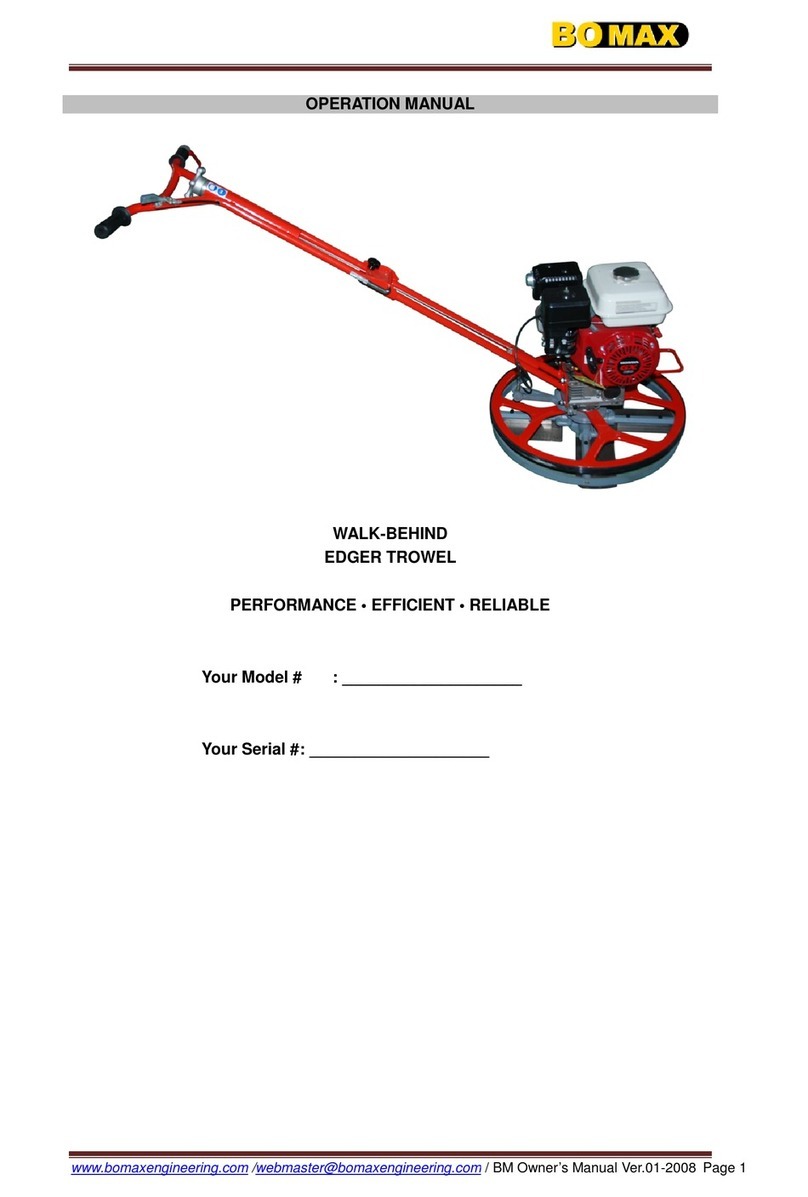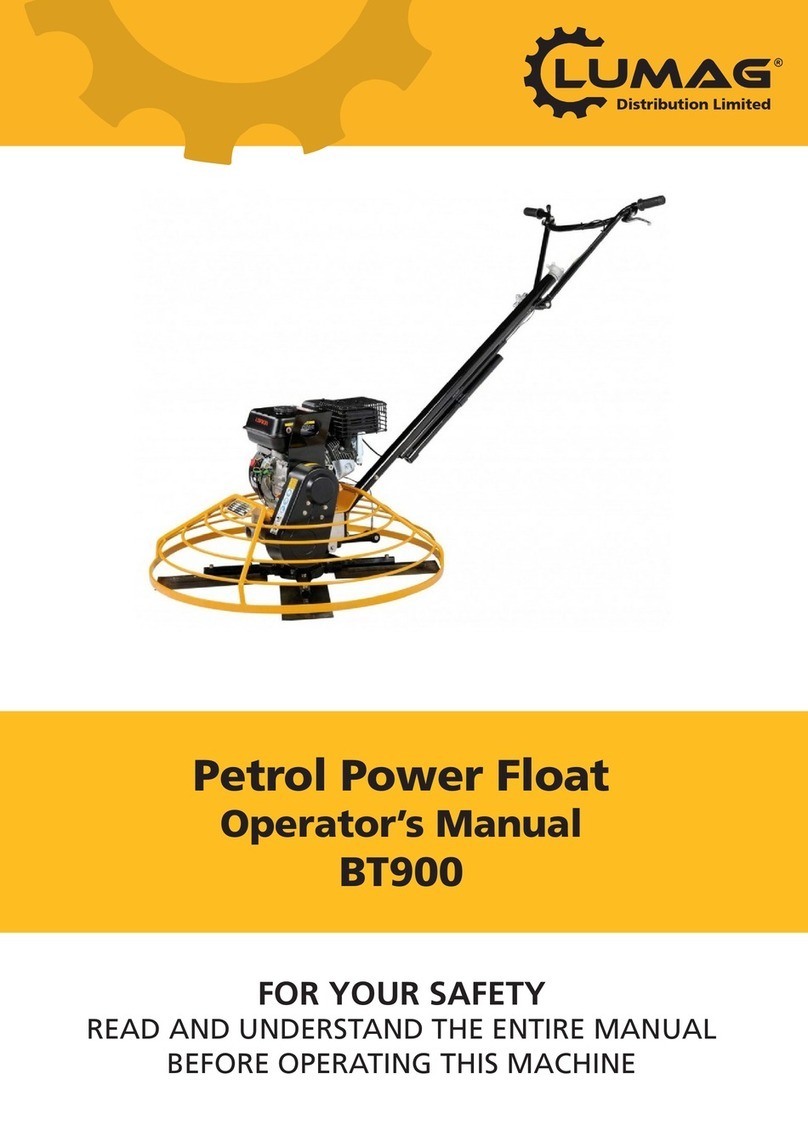Stark 61024 Original instruction manual

36” WALK BEHIND POWER TROWEL
SAVE THIS MANUAL: KEEP THIS MANUAL FOR SAFETY WARNINGS, PRECAUTIONS, ASSEMBLY,
OPERATING, INSPECTION, MAINTENANCE AND CLEANING PROCEDURES. WRITE THE
PRODUCT’S SERIAL NUMBER ON THE BACK OF THE MANUAL NEAR THE ASSEMBLY DIAGRAM
(OR MONTH AND YEAR OF PURCHASE IF PRODUCT HAS NO NUMBER).
OWNER’S MANUAL AND SAFETY INSTRUCTIONS
ITEM: 61024 & 61025
FOR QUESTIONS PLEASE CALL OUR CUSTOMER SUPPORT: (909) 628 4900 MON-FRI 9AM TO 3PM PST

IMPORTANT SAFETY INFORMATION
GENERAL SAFETY WARNINGS
Read all safety warnings and instructions. Failure to follow the warnings and instructions
may result in electric shock, re and/or serious injury. Save all warnings and instructions
for future reference.
SAFETY
The warnings, precautions, and instructions discussed in this instruction manual cannot cover
all possible conditions and situations that may occur. It must be understood by the operator
that common sense and caution are factors which cannot be built into this product, but must be
supplied by the operator. Read carefully and understand all ASSEMBLY AND OPERATION
INSTRUCTIONS before operating. Failure to follow the safety rules and other basic safety
precautions may result in serious personal injury.
Stay alert, watch what you are doing, and use common sense when operating the tool. Do not use the
tool while you are tired or under the inuence of drugs, alcohol, or medication.
1
Read and understand all instructions. Failure to follow all instructions may result in serious injury
or property damage.
Do not allow persons to operate or assemble the product until they have read this manual and
have developed a thorough understanding of how it works.
Do not modify this product in any way. Unauthorized modication may impair the function and/or
safety and could affect the life of the product. There are specic applications for which the product
was designed.
Use the right tool for the job. DO NOT attempt to force small equipment to do the work of larger
industrial equipment. There are certain applications for which this equipment was designed. This
product will be safer and do a better job at the capacity for which it was intended. DO NOT use
this equipment for a purpose for which it was not intended.
Inspect the work area before each use. Keep work area clean, dry, free of clutter, and well-lit.
Cluttered, wet, or dark work areas can result in injury.
Never operate the machine with the belt guard missing. Exposed drive belt and pulleys create
potentially dangerous hazards that can cause serious injuries.
Never use the trowel around pop-ups in the concrete that are lower than the lowest ring on the ring
guard.
Keep children and bystanders away from the work area while operating the tool. Do not allow
children to handle the product.
Always close fuel valve on engines equipped with one when machine is not being operated.
Always operate machine with all safety devices and guards in place and in working order. DO
NOT modify or defeat safety devices. DO NOT operate machine if any safety devices or guards are
missing or inoperative.

IMPORTANT SAFETY INFORMATION
Dress properly. Do not wear loose clothing, dangling objects, or jewellery. Keep your hair, clothing and
gloves away from moving parts. Loose clothes, jewellery, or long hair can be caught in moving parts.
Wear the proper personal protective equipment when necessary. Use ANSI Z87.1 compliant
safety goggles (not safety glasses) with side shields, or when needed, a face shield. Use a dust mask
in dusty work conditions. Also use non-skid safety shoes, hard-hat, gloves, dust collection systems,
and hearing protection when appropriate. This applies to all persons in the work area.
Always test the function of the engine control module before operating the trowel. DO NOT operate
the trowel if the engine control module is not functioning properly.
2
DANGER: Internal combustion engines present special hazards during operation and fuelling. Read
and follow the warning instructions in the engine owner’s manual and the safety guidelines below.
Failure to follow the warnings and safety guidelines could result in severe injury or death.
Check for damaged parts before each use. Carefully check that the product will operate properly
and perform its intended function. Replace damaged or worn parts immediately. Never operate the
product with a damaged part.
DO NOT run the machine indoors or in an enclosed area such as a deep trench unless adequate
ventilation, through such items as exhaust fans or hoses, is provided. Exhaust gas from the
engine contains poisonous carbon monoxide gas; exposure to carbon monoxide can cause loss of
consciousness and may lead to death.
WARNING: Poorly maintained equipment can become a safety hazard! In order for the equipment to
operate safely and properly over a long period of time, periodic maintenance and occasional repairs
are necessary.
DO NOT attempt to clean or service the machine while it is running. Rotating parts
can cause severe injury.
DO NOT crank a ooded engine with the spark plug removed on gasoline-powered engines. Fuel
trapped in the cylinder will squirt out the spark plug opening.
DO NOT test for spark on gasoline-powered engines if the engine is ooded or the smell of gasoline
is present. A stray spark could ignite the fumes.
DO NOT use gasoline or other types of fuels or ammable solvents to clean parts, especially in
enclosed areas. Fumes from fuels and solvents can become explosive.
DO NOT remove blades while the machine is hanging overhead.
ALWAYS support the machine securely before changing blades.
ALWAYS disconnect the spark plug on machines equipped with gasoline engines, before servicing,
to avoid accidental start-up.
ALWAYS keep the machine clean and labels legible. Replace all missing and hard-to-read labels.
Labels provide important operating instructions and warn of dangers and hazards.
ALWAYS handle blades carefully. The blades can develop sharp edges which can cause serious
cuts.

3
OPERATION
HIGH & LOW TURN WHEEL
ENGINE
OIL ENTRANCE
GUARD RING
THROTTLE
LEVER
ASSEMBLY
SAFE SWITCH
DECELERATION MACHINE
BLADE
BEFORE STARTING check the following:
Oil level in engine
Oil level in gearbox
Fuel level
Condition of air lter
Condition of fuel lines
Condition of trowel arms and blades
Condition of ring guards
Label descriptions
Handle height to suit operator
To prevent uncontrolled spinning of the trowel, the engine control module is designed to shut off the
engine under certain conditions. For example, if the operator loses his/her grip on the trowel, the
engine control module will sense that the machine is spinning and shut off the engine.
WARNING: Do not lift the trowel overhead with a oat pan attached, as the pan
could fall off and strike personnel working in the vicinity.

4
OPERATION
Oil level in gearbox
Condition of air lter
Condition of fuel lines
Condition of trowel arms and blades
Condition of ring guards
Label descriptions
Handle height to suit operator
1. Open the Flameout switch.
Start Up
2. Open the Safe Switch to “ON”
3. Open the Fuel Switch
4. Close the Block Wind Door
5. Put the Oil Door Switch in the middle position
←
←
←
←
←

OPERATION
5
6. With one hand on the buttress handle, draw the engine handle
with the other.
←
7. Warm up the engine for three to ve minutes rst, then open the
block wind door.
8. Adjust the blades to the proper height.
9. With both hands hold the handle, then adjust the switch of the
Oil Door to the proper running sped for operation.
10. To turn off, put the switch of the Oil Door to “L”. Put the Safe
Switch to “Close”, then put the blades to level position.

OPERATION
6
WARNING: ALWAYS test the function of the engine control module before operating the trowel. DO
NOT operate the trowel if the engine control module is not functioning properly.
Choose correct blade type and attach blades to trowel arms. Do not mix oat or nish blades with
combination blades.
CAUTION: Do not attempt to adjust handle height on the trowel while it is running.
WARNING: Allow the mufer to cool before cleaning or servicing the machine. A hot mufer could
ignite the fuel and start a re.
WARNING: Personnel other than the trowel operator should not be allowed in the work area, as severe
injury can occur from contact with operating trowel blades.
MAINTENANCE The chart below lists basic machine and engine maintenance.
Perform initially after rst 20 hours of operation.
In the interests of environmental protection, place a plastic sheet and a container under the machine
to collect any liquid which drains off. Dispose of this liquid in accordance with environmental protection
legislation.

MAINTENANCE
ENGINE OIL:
Drain oil while the engine is still warm.
Remove the oil ll plug and drain cap to drain oil.
Install drain cap.
Fill the engine crankcase with recommended oil up to the level of the plug opening.
AIR CLEANER:
Service air cleaner frequently to prevent carburetor malfunction. NEVER run engine without air cleaner.
Severe engine damage will occur. NEVER use gasoline or other types of low ash point solvents for
cleaning the air cleaner. A re or explosion could result.
Remove air cleaner cover. Remove both elements and inspect them for holes or tears. Replace
damaged elements.
Wash foam element (b) in solution of mild detergent and warm water. Rinse thoroughly in clean water.
Allow element to dry thoroughly. Soak element in clean engine oil and squeeze out excess oil.
Tap paper element lightly to remove excess dirt. Replace paper element if it appears heavily soiled.
SPARK PLUG:
Clean or replace the spark plug as needed to ensure proper operation. CAUTION A loose spark plug
can become very hot and may cause engine damage.
Remove the spark plug and inspect it.
Replace the spark plug if the insulator is cracked or chipped.
Clean the spark plug electrodes with a wire brush.
Set the electrode gap.
Tighten the spark plug securely.
CLEANING SEDIMENT CUP:
Turn the fuel valve off.
Remove the sediment cup and the O-ring.
Wash both thoroughly in a non-ammable solvent. Dry and reinstall them.
Turn the fuel valve on and check for leaks.
ADJUSTING IDLE SPEED:
WARNING: Remove the drive belt before making any adjustment to the carburetor. The blades will
engage unless the belt is removed from the machine.
Start the engine and allow it to warm up to normal operating temperature.
Turn the throttle stop screw in to increase speed, out to decrease speed. Make sure the throttle lever is
touching the stop screw before measuring rpm.
7

BELT REPLACEMENT:
The trowel is equipped with a self-adjusting clutch. This clutch automatically tightens the belt and
compensates for belt wear. Replace the belt if the clutch can no longer tighten belt enough to engage
gearbox without slipping. To replace the drive belt:
Disconnect the spark plug lead. WARNING: To avoid accidental starting of the engine, always
disconnect the spark plug lead before working on machine.
Loosen the screws and remove the belt guard.
Slowly turn the pulley and roll the belt off.
MAINTENANCE
Install the new belt.
Reattach the belt guard with washers and screws.
STORAGE:
If trowel is being stored for more than 30 days:
Change engine oil.
Drain fuel from engine.
Remove spark plug and pour 15 ml (½ ounce) of SAE 30 engine oil into the cylinder. Replace spark
plug and crank engine to distribute oil.
Clean dirt from cylinder, cylinder head ns, blower housing, rotating screen, and mufer areas.
Cover trowel and engine and store in a clean, dry area.
8

PRECAUTIONS
The trowel manufacturer has no direct control over machine application, operation, inspection,
lubrication, or maintenance. Therefore, it is your responsibility to use good safety practices in these
areas.
Do not use the trowel for any purpose other than its intended purposes or applications.
Know the capabilities and limitations of the trowel.
Walk around the trowel. Carefully inspect for evidence of physical damage, such as cracks,
bends, or deformation of plates and welds. Check for loose, broken or missing parts on the trowel,
including brackets, vibration isolators, nuts and bolts. Hardware should be replaced with original
equipment manufacturer’s (OEM) parts, and should be properly tightened to the manufacturer’s
recommendations.
Never check for hydraulic leaks with your hand. Hydraulic systems are under high pressure and leaks
in these systems can penetrate the skin which can result in serious injury or even death. Always use a
piece of cardboard or wood when looking for hydraulic leaks.
Exhaust from the engine contains poisonous carbon monoxide gas that is not easily detected as it is
colorless and odorless. Exposure to carbon monoxide can cause loss of consciousness and may lead
to death! Do not operate your trowel indoors or in an enclosed area unless adequate ventilation is
provided. Ensure that permissible carbon monoxide levels are monitored and not exceeded.
The mufer, exhaust pipes and other engine parts will become hot during operation and will remain hot
for a while after shut down. Do not touch until allowed to sufciently cool. Do not allow debris, rags,
paper, or leaves to accumulate around these areas.
MAINTENANCE AND TROUBLESHOOTING
9

PRECAUTIONS
Never operate a trowel with a damaged or worn electrical cord. When using an extension cord, be sure
to use one heavy enough to carry the current load. When trowel is used outdoors, use only extension
cords that are marked for outdoor use.
Batteries produce explosive gases. Keep open ame or sparks away. See the manufacturer’s
instructions when servicing the batteries, when using jumper cables, or when using a battery charger.
Use a ashlight to check battery electrolyte level. Always check with engine stopped. Battery electrolyte
is poisonous. It is strong enough to burn your skin, eat holes in clothing, and can cause blindness if
splashed into eyes. Always wear eye and face protection.
Be sure the trowel is properly lubricated. See that the fuel, lubricating oil, coolant and hydraulic
reservoirs are lled to the proper levels with the correct uids.
Never overll fuel tanks or uid reservoirs. In the event of a fuel spill, do not attempt to start the engine
until the fuel residue has been completely wiped up, and the area surrounding the engine is dry.
Replace fuel cap securely after refuelling.
PLEASE READ THE FOLLOWING CAREFULLY
Record Product’s Serial Number Here:
Note: If product has no serial number, record month and year of purchase instead.
Note: Some parts are listed and shown for illustration purposes only and are not available
individually as replacement parts.
10
THE MANUFACTURER AND/OR DISTRIBUTOR HAS PROVIDED THE PARTS LIST AND ASSEMBLY
DIAGRAM IN THIS MANUAL AS A REFERENCE TOOL ONLY. NEITHER THE MANUFACTURER OR
DISTRIBUTOR MAKES ANY REPRESENTATION OR WARRANTY OF ANY KIND TO THE BUYER THAT
HE OR SHE IS QUALIFIED TO MAKE ANY REPAIRS TO THE PRODUCT, OR THAT HE OR SHE IS
QUALIFIED TO REPLACE ANY PARTS OF THE PRODUCT. IN FACT, THE MANUFACTURER AND/OR
DISTRIBUTOR EXPRESSLY STATES THAT ALL REPAIRS AND PARTS REPLACEMENTS SHOULD BE
UNDERTAKEN BY CERTIFIEDAND LICENSED TECHNICIANS,AND NOT BY THE BUYER. THE BUYER
ASSUMES ALL RISK AND LIABILITY ARISING OUT OF HIS OR HER REPAIRS TO THE ORIGINAL
PRODUCT OR REPLACEMENT PARTS THERETO, OR ARISING OUT OF HIS OR HER INSTALLATION
OF REPLACEMENT PARTS THERETO.
This manual suits for next models
1
Table of contents
Popular Trowel manuals by other brands
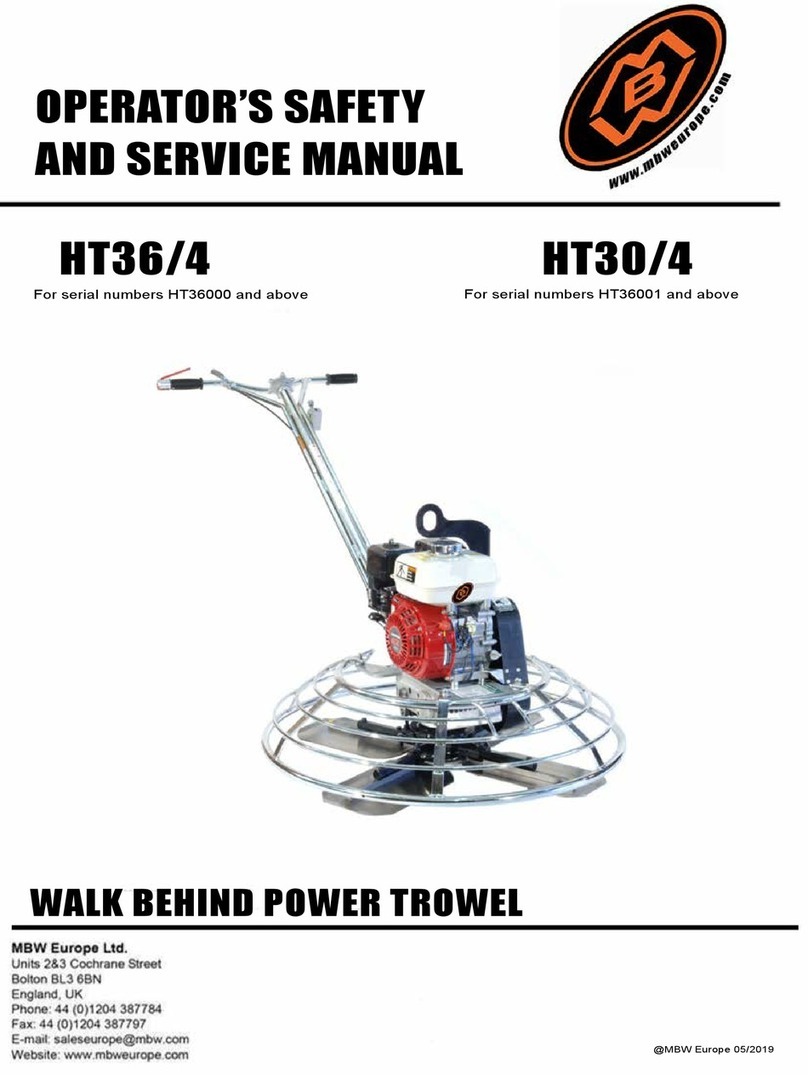
MBW
MBW HT36/4 Operator's safety and service manual
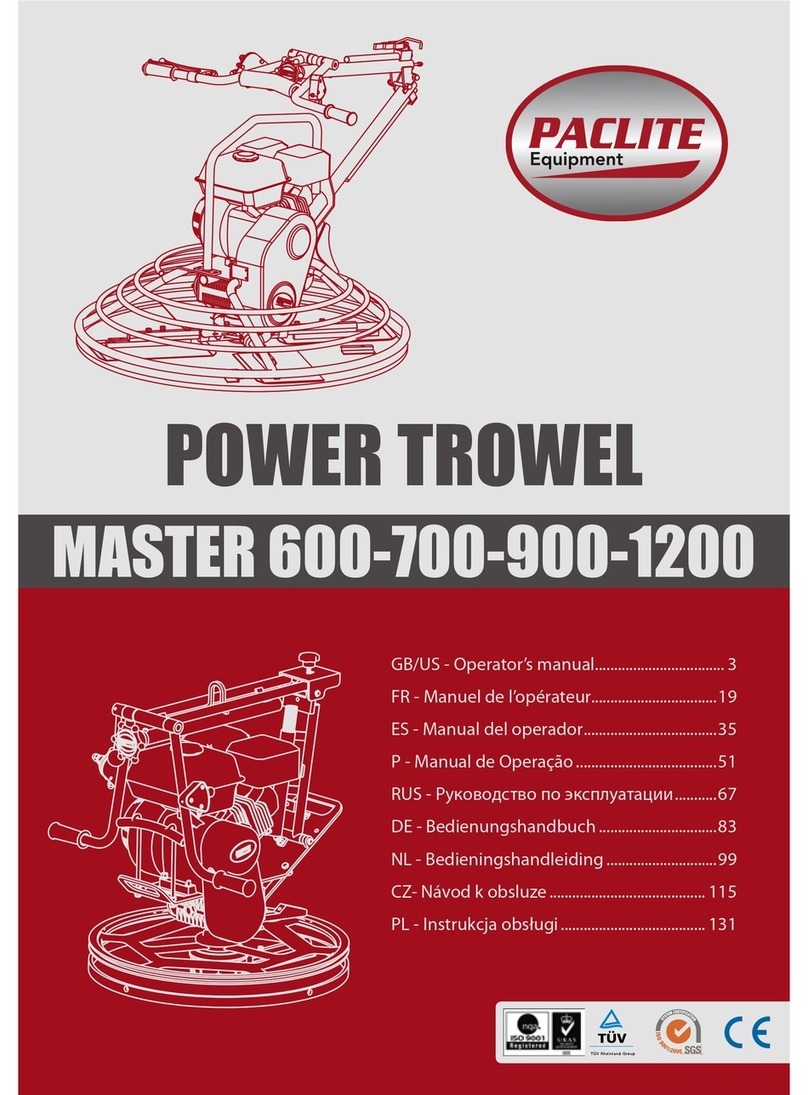
PACLITE Equipment
PACLITE Equipment MASTER 600 operating manual
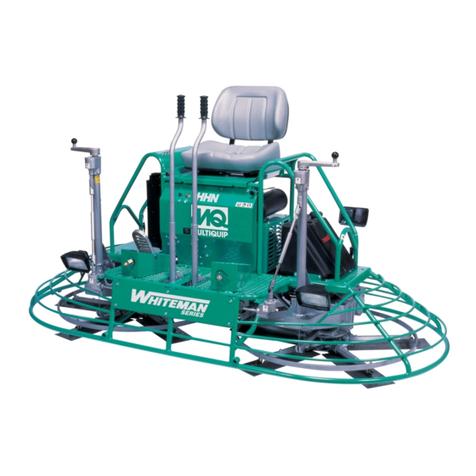
MULTIQUIP
MULTIQUIP hhn34tvdtcsl4 Operation manual
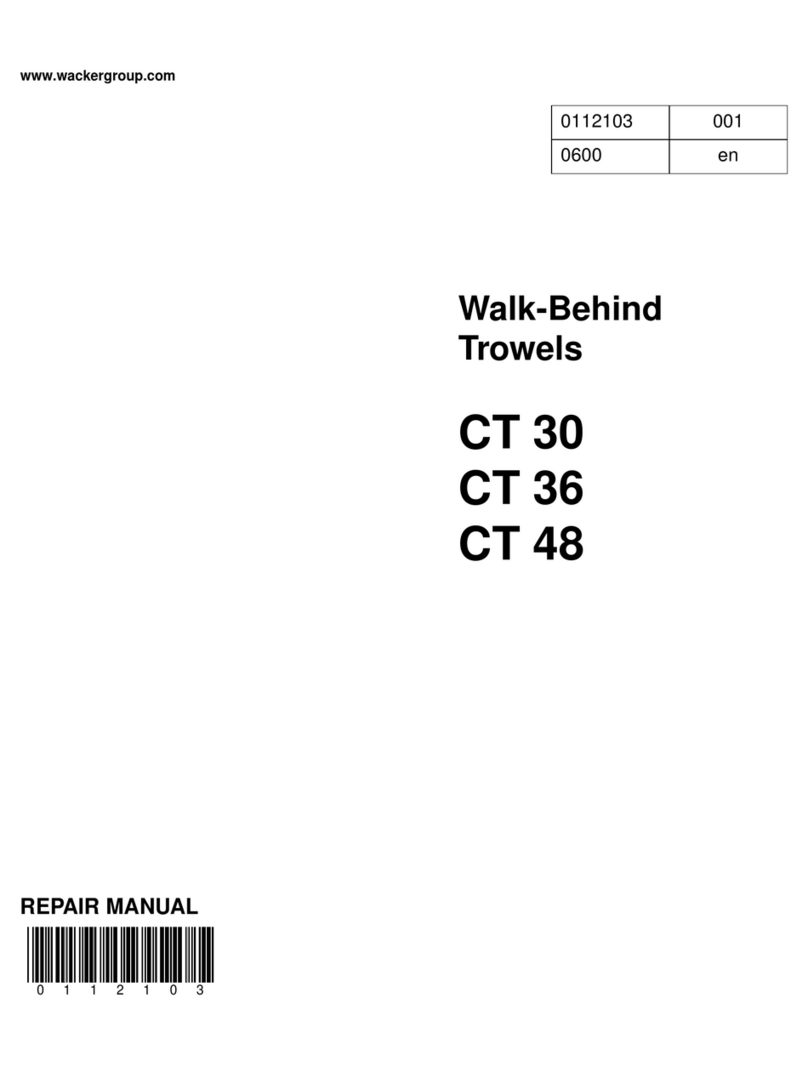
WACKER Group
WACKER Group CT 30 Series Repair manual
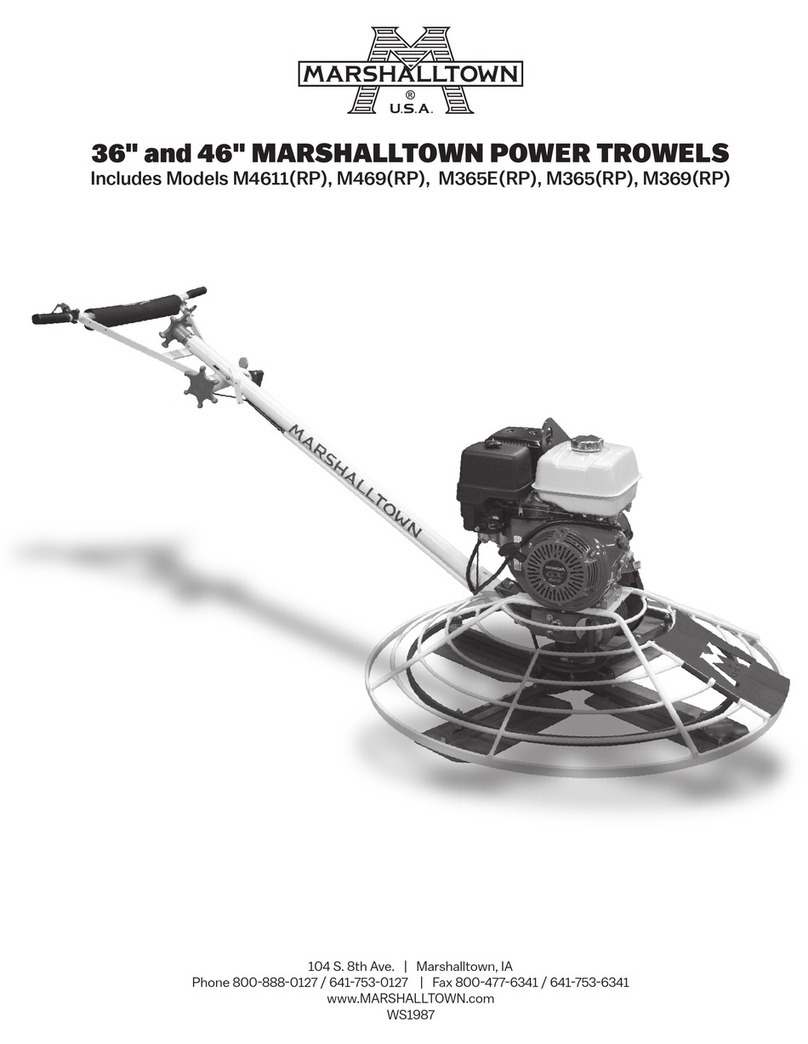
Marshalltown
Marshalltown M4611 manual
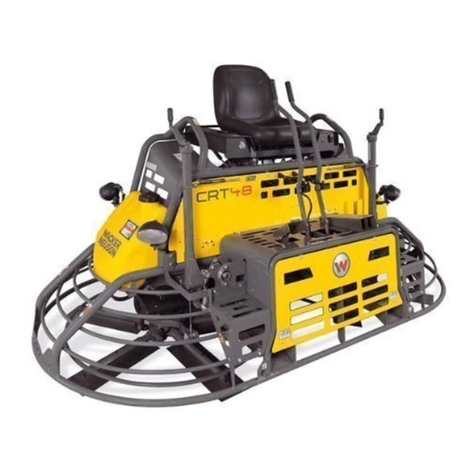
Wacker Neuson
Wacker Neuson CRT 48-31V Operator's manual
